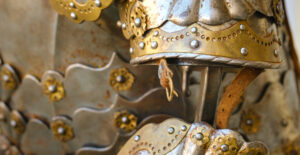
Down one of the quieter side streets behind the busy jewellery arcades in Durban, a single-room workshop hums softly. The sound isn’t loud. It’s the steady tap of metal being worked by hand, the scrape of a file against gold, and the low murmur of a radio left on for company. Behind a worn wooden workbench sits a man in his sixties, his hands moving with a rhythm that looks effortless, though it has taken decades to master. He is one of South Africa’s last old-school goldsmiths, still shaping jewellery the way it was done before computers, machines, and mass production took over.
His tools aren’t digital. They are small hammers, delicate pliers, casting molds blackened from years of use, and a single soldering torch that has seen better days. Pieces of gold in raw form sit in little piles on the table, old bangles brought in to be reshaped, inherited rings waiting to be repaired, wedding bands that have lost their shine and need to be made whole again. There’s no computer-controlled engraving machine in sight. Every mark made here is made by hand.
This kind of workshop used to be common across South African cities, especially in places like Johannesburg’s CBD or Port Elizabeth’s older districts. Small family-run jewellery businesses where skills were passed from one generation to the next, learned not in schools but standing over benches exactly like this one. But in 2025, those workshops have mostly disappeared. Mass-produced jewellery fills shop windows now. Big brands ship in factory-made pieces from overseas. But here, in this small room, the old ways still matter.
The goldsmith works alone most days. His sons have chosen different paths, office jobs, safer work. It’s quieter now. Customers still come, mostly through word of mouth. People who want something fixed rather than replaced, or who want a custom piece made not by a machine, but by a pair of hands that understand gold not as a commodity, but as something with weight, feel, and meaning.
The process is slow. Someone might bring in a chain that snapped years ago and sat forgotten in a drawer. The goldsmith will study it quietly, run it between his fingers, test its weight. There’s no rush. Each repair, each new creation, is treated like its own project. Melting the gold down, shaping it into a new form, hammering it smooth again, these are actions repeated hundreds, even thousands of times, but never with less care.
What stands out in a place like this is how much of the work isn’t about making things new, but about preserving what already exists. A woman brings in her late husband’s wedding band, too big now for her to wear, and asks for it to be resized. A young man comes in with his grandmother’s earrings, one of them bent out of shape after years in a box. These aren’t purchases. They’re acts of memory. In a workshop like this, jewellery isn’t just decoration. It’s history, locked into metal.
 The goldsmith doesn’t advertise. There’s no flashy sign outside, no website, no Instagram page showing off his latest pieces. Business comes from people who know where to find him, who have been coming to him for years, or who were told by a friend that this is the man you go to when you want something done right. It’s a kind of trust that doesn’t exist in chain stores or online shops.
The goldsmith doesn’t advertise. There’s no flashy sign outside, no website, no Instagram page showing off his latest pieces. Business comes from people who know where to find him, who have been coming to him for years, or who were told by a friend that this is the man you go to when you want something done right. It’s a kind of trust that doesn’t exist in chain stores or online shops.
The work itself isn’t glamorous. Hands blackened by soot, gold dust scattered across the floor, small burns on the workbench from a misdirected flame. But there’s a quiet dignity in it. In a country where fast fashion and quick turnarounds dominate most industries, holding onto a craft like this feels almost rebellious.
Even as modern jewellery-making technology advances, laser engravers, 3D printers, automatic casting machines, there’s something people still value about human-made imperfection. A slight difference in shape from one piece to another. A tiny mark that shows where the hammer touched too hard. It makes the piece feel alive in a way machine-made gold can’t.
Across South Africa, there are only a handful of workshops like this left. In Johannesburg’s old jewellery district, a few stubborn shops still keep their benches running. In Cape Town’s less tourist-focused streets, there are older artisans quietly keeping the same traditions alive. But the numbers are thinning out. Younger generations often don’t see the value in such slow, manual work. The goldsmith himself admits he doesn’t know how much longer his workshop will stay open. But for now, he keeps working.
The customers who find their way here leave with more than just a repaired chain or a newly shaped ring. They leave with a piece of a slower world, where things are made to last, not just to sell. There’s a difference between buying something off the shelf and knowing it was shaped from raw metal by hand, every edge and curve adjusted until it felt exactly right.
Outside the workshop, the city keeps moving. Cars weave through traffic. Shoppers hurry past with plastic bags. But inside, the radio plays on, the torch hisses quietly, and the goldsmith’s hands keep working. Gold is gold, it holds its value in any form. But in places like this, it holds something else too, time, patience, and the weight of craft that refuses to disappear quietly.



